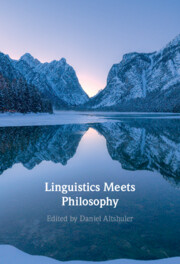Book contents
- Linguistics Meets Philosophy
- Linguistics Meets Philosophy
- Copyright page
- Contents
- Figures
- Tables
- Contributors
- Linguistics Meets Philosophy: A Historical Preface
- Introduction
- Part I Reporting and Ascribing
- Part II Describing and Referring
- Part III Narrating and Structuring
- 5 On the Role of Relations and Structure In Discourse Interpretation
- 6 Narrative and Point of View
- Part IV Locating and Inferring
- Part V Typologizing and Ontologizing
- Part VI Determining and Questioning
- Part VII Arguing and Rejecting
- Part VIII Implying and (Pre)supposing
- Index
- References
5 - On the Role of Relations and Structure In Discourse Interpretation
from Part III - Narrating and Structuring
Published online by Cambridge University Press: 06 October 2022
- Linguistics Meets Philosophy
- Linguistics Meets Philosophy
- Copyright page
- Contents
- Figures
- Tables
- Contributors
- Linguistics Meets Philosophy: A Historical Preface
- Introduction
- Part I Reporting and Ascribing
- Part II Describing and Referring
- Part III Narrating and Structuring
- 5 On the Role of Relations and Structure In Discourse Interpretation
- 6 Narrative and Point of View
- Part IV Locating and Inferring
- Part V Typologizing and Ontologizing
- Part VI Determining and Questioning
- Part VII Arguing and Rejecting
- Part VIII Implying and (Pre)supposing
- Index
- References
Summary
This chapter focuses on the role that discourse relations and structure play in a variety of phenomena of interest to semanticists and philosophers. Not only do discourse relations add semantic content above and beyond the individual propositions expressed by the utterances in a discourse, but they, and the complex structures to which they give rise, can influence the interpretations of individual utterances, having an effect on the very propositions the utterances are understood to express. In this chapter, we look in detail at how theories of discourse structure can be brought to bear on at-issue and non-at-issue content, using appositive relative clauses and discourse parenthetical reports as illustrations. We also discuss recent efforts to use discourse structure to model conversational goals and capture the subjective nature of discourse interpretation as well as recent work extending theories of discourse structure to multimodal discourse. Along the way, we emphasize the importance of corpus work in studying discursive phenomena and raise a series of large questions to be pursued in future work.
Keywords
- Type
- Chapter
- Information
- Linguistics Meets Philosophy , pp. 139 - 175Publisher: Cambridge University PressPrint publication year: 2022
References
- 1
- Cited by

